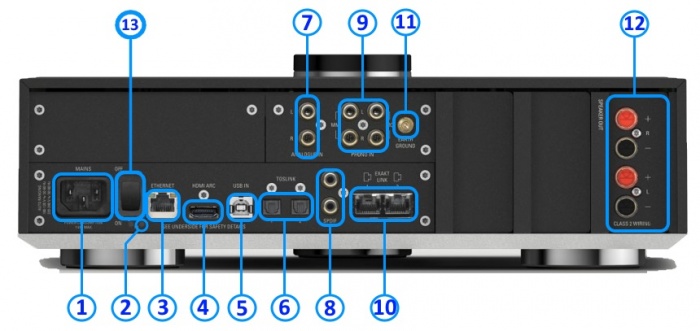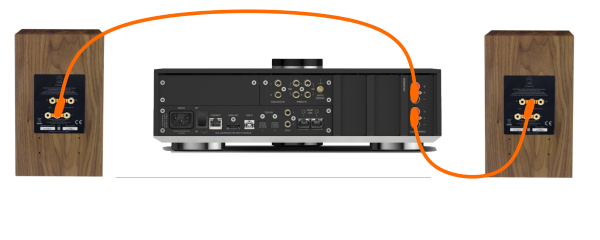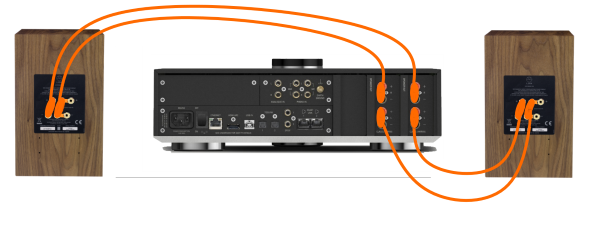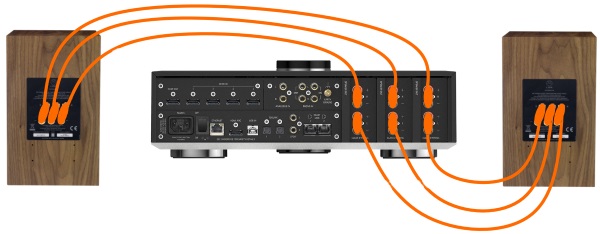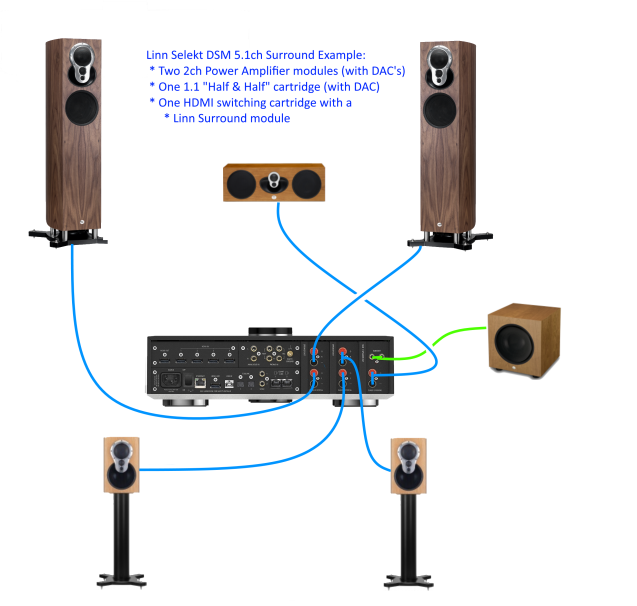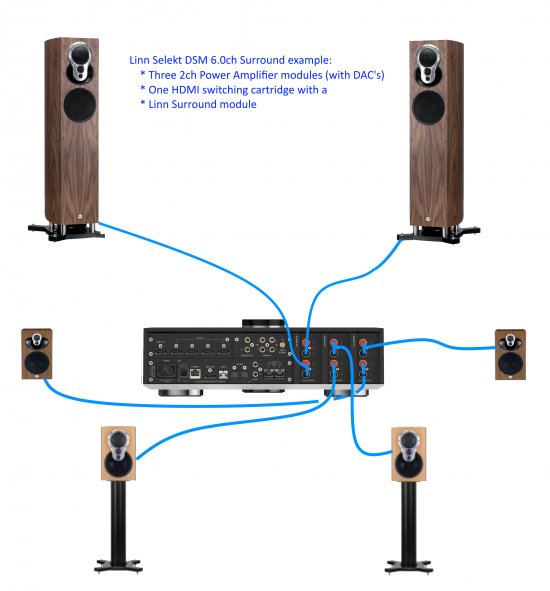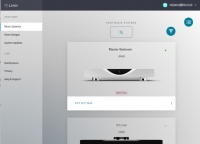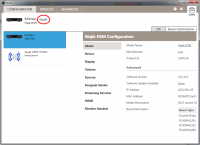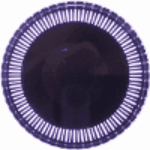Selekt DSM/Setup
Linn Setup Guide:
How to set up the Linn Selekt DSM
Initial Configuration
The Selekt DSM is a product can can take multiple cartridge and modules to allow it to be configured to your requirements. This can be changed and expanded in the future but please ensure that you have informed your Linn Retailer of your initial requirements before purchase.
- Considerations before installation, make sure that you have
-
- A mains power socket
Stable mains supply
- 100-120V rms 50~60Hz,
- 220-240V rms 50~60Hz
- A ethernet/LAN connection to your broadband Router. (You will need to connect it to a wired network connection to allow setup and configuration. Then you can use the Wifi capabilities of your network to control and stream music to the Selekt DSM)
- The HDMI connection from you TV, (and any HDMI source if you have the Selekt HDMI switching module) are not too long and are the correct spec HDMI certified cables.
- The product has adequate ventilation for operation.
- The required Cartridge and Modules have been supplied.
- Positioning Information
Cartridge description
As the Selekt DSM is modular then these have to be fitted to the Selekt DSM. Some of these cartridges/modules are fitted when you order the Selekt product, but check what you have installed first using the Konfig App
These "cartridges/modules" can be used as upgrades or changes to your product. The Selekt DSM will probably need re-configured by Manage Systems after any cartridge/module changes.
- *Selekt single-channel line-out cartridge - Single channel pre-amplifier line level audio cartridge that can be used in Mono playback.Must be used in pairs. However, these can be used in a surround sound channel setup. Only using a pair of Mono cartridges in the Selekt DSM and the remaining surround channels must be assigned to Exaktbox(es) and/or Exakt speakers.
- *Selekt 2-channel line-out cartridge - 2 channel pre-amplifier line level audio cartridge that can be used in Stereo or assigned a surround sound channel setup.
- *Selekt 2-channel power amplifier cartridge - 2 channel Power amplifier cartridge that can be used in Stereo, Bi-Amp, Tri-Amp or assigned a Surround sound channel setup
- *Selekt combined/hybrid power amplifier and line-out cartridge - 2 channel cartridge with:
- * One channel for Line-level playback (for Sub-Woofer) and
- * One channel for Power Amplifier Centre Channel playback. (This is designed to be used with other Selekt Power Amplifier cartridges.)
- *Selekt Standard DAC module - DAC module using the standard DAC
- *Selekt Katalyst DAC module - DAC module using the Katalyst DAC
- *Selekt Organik DAC module - DAC module using the Organik DAC
- Two modules available,
- one for Selekt single-channel line-out cartridge and
- one all the other Selekt, all variants, cartridges. (Selekt 2-channel line-out cartridge + Selekt 2-channel power amplifier cartridge)
- Two modules available,
- *Selekt HDMI Switching module & Linn Surround module - This allows the addition of HDMI switching and a further upgrade to Surround sound
Note:
- It should be noted that information may at times be out of date and should not be used as a current list of what is upgrades available.
- Adding more than one cartridge and/or an HDMI switching module on early Selekt DSM's may require a power supply upgrade. Please information can be found by your Linn Retailer at the time of ordering.
- Warning: Changing Selekt Cartidge(s) or Module(s).
- Applies to: All Selekt DSM variants
- To reduce the risk of damage to your Selekt DSM:
- The Selekt DSM MUST be disconnected from Mains power supply by BEFORE any cartridge(s) or module(s) are removed/Inserted.
Unpacking
- Remove the Selekt DSM from the packing and check you have all of the accessories.
- If you purchased any extra module/cartridge then please make sure that these have been installed correctly BEFORE placing your Selekt DSM in to its final location.
Wiring
- This is all dependent on cartridges and modules that are installed in your Selekt DSM.
Note:
- An upgrade to the Selekt Power supply may be required to use any new modules.
- Power Amplifier outputs: These are CLASS-D amplifier outputs and speakers should ONLY be connected/disconnected when the product in is Sleep state or powered OFF.
- Some Electrostatic speakers may require a modification to work with Linn Class-D amplifier. Please refer to the speaker manufacturer's website for information.
- The Selekt power amplifiers have a slightly lower gain than other Linn power amplifiers, (original Majik/Akurate..). If you are going to Bi-Amp a pair of speakers then we would recommend either ALL Selekt Power amplifier cartridges or ALL Selekt Line level cartridges with external amplifiers.
Selekt DSM with one Line-level cartridge
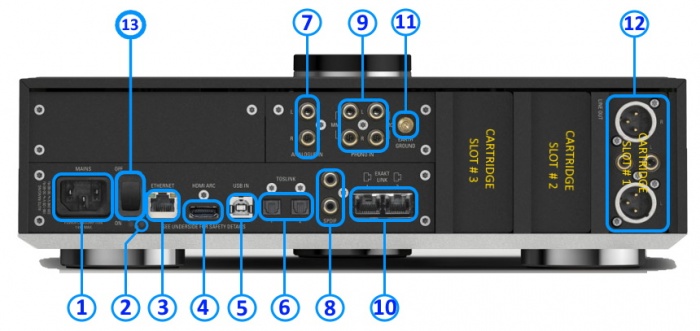
Information of what each connector is and a basic specification of these connectors
- MAINS INPUT - To connect to the mains electricity supply.
- FALLBACK - To put the device into Fallback mode (used when reprogramming)
- ETHERNET - To connect to a network (100Base-T)
- HDMI ARC (HDMI) - To connect to a TV Audio Return Channel (ARC) connection
- USB-B socket - To connect to a PC/MAC for Class 2.0 PCM Asynchronous USB Audio playback 6
- DIGITAL INPUTS (Toslink)5 - To connect sources with Toslink (optical) digital outputs.
- ANALOGUE INPUTS (RCAline level)1 & 2 - To connect sources with RCA analogue outputs.
- DIGITAL INPUTS/OUTPUT (Spdif)5 - To connect sources with Spdif (RCA) digital outputs.
- ANALOGUE INPUTS (RCA MM/MC)2 & 3 - To connect a turntable with unbalanced (RCA) outputs.
- EXAKT LINK - To connect to Exakt compatible devices (Exaktbox, Exakt Speakers, Urika II etc)
- PHONO GROUND - To connect to a turntable grounding terminal.
- ANALOGUE OUTPUTS (XLR & RCA,variable level)4 - To connect to a power amplifier.
- POWER SWITCH - Mains power switch
Notes:
1 Analogue inputs: Input range adjustable 1V-4V rms, impedance 10kΩ
2 with ADC of 192kHz/24bit
3 RCA MM/MC:
- MM input impedance 47k, 100pf
- MM max voltage (1kHz): 67mV rms. (Gain +40dB)
- MC input impedance 100Ω 470p
- MC max voltage (1kHz): 5.5mV rms (Gain +54dB)
4 Analogue Output:
- RCA - 2V rms, 300Ω
- XLR - 4V rms, 600Ω
5 Digital inputs: 32kHz, 44.1kHz, 48kHz, 88.2kHz, 96kHz, 176.4kHz, 192kHz
- SPDIF1 can be converted to a 2-channel SPDIF OUTPUT, audio that will support up to 192KHz via Manage Systems
- This output is a fixed volume control output..
- Only supports FL/FR channel output. (even if playing Surround audio)
- SPDIF2 is ALWAYS a SPDIF INPUT and CANNOT be configured as a SPDIF output.
- SPDIF1 can be converted to a 2-channel SPDIF OUTPUT, audio that will support up to 192KHz via Manage Systems
6 USB Supported Sample rates: 44.1kHz, 48kHz, 88.2kHz, 96kHz, 176.4kHz, 192kHz
Selekt DSM with one Power Amplifier cartridge
- MAINS INPUT - To connect to the mains electricity supply.
- FALLBACK - To put the device into Fallback mode (used when reprogramming)
- ETHERNET - To connect to a network (100Base-T)
- HDMI ARC - To connect to a TV Audio Return Channel (ARC) connection
- USB-B socket - To connect to a PC/MAC for Class 2.0 PCM Asynchronous USB Audio playback 9
- DIGITAL INPUTS (Toslink)5 - To connect sources with Toslink (optical) digital outputs.
- ANALOGUE INPUTS (RCAline level)1 & 2 - To connect sources with RCA analogue outputs.
- DIGITAL INPUTS/OUTPUT (Spdif)5 - To connect sources with Spdif (RCA) digital outputs.
- ANALOGUE INPUTS (RCA MM/MC)2 & 3 - To connect a turntable with unbalanced (RCA) outputs.
- EXAKT LINK- To connect to Exakt compatible devices (Exaktbox, Exakt Speakers, Urika II)
- PHONO GROUND - To connect to a turntable grounding terminal.
- POWER AMPLIFIER OUTPUTS6 ,7 & 8 - To connect directly to a pair of loudspeakers.
- POWER SWITCH - Mains power switch
Notes:
1 Analogue inputs: Input range adjustable 1V-4V rms, 10kΩ impedance
2 with ADC of 192kHz/24bit
3 RCA MM/MC:
- MM input impedance 47k, 100pf
- MM max voltage (1kHz): 67mV rms. (Gain +40dB)
- MC input impedance 100Ω 470p
- MC max voltage (1kHz): 5.5mV rms (Gain +54dB)
5 Digital inputs: 32kHz, 44.1kHz, 48kHz, 88.2kHz, 96kHz, 176.4kHz, 192kHz
- SPDIF1 can be converted to a 2-channel SPDIF OUTPUT, audio that will support up to 192KHz via Manage Systems
- This output is a fixed volume control output..
- Only supports FL/FR channel output. (even if playing Surround audio)
- SPDIF2 is ALWAYS a SPDIF INPUT and CANNOT be configured as a SPDIF output.
- SPDIF1 can be converted to a 2-channel SPDIF OUTPUT, audio that will support up to 192KHz via Manage Systems
6 Power Amplifier outputs: These are CLASS-D amplifier outputs and speakers should ONLY be connected/disconnected when the product in is Sleep state or powered OFF.
7 Power Amplifier outputs: Max 100W/4Ω, 50W/8Ω per channel, Gain 20dB
- The Selekt power amplfiers have a slightly lower gain than other Linn power amplifiers, (Majik/Akurate..). If you are going to Bi-Amp a pair of speakers then we would recommend either ALL Selekt Power amplifier cartridges or ALL Selekt Line level cartridges with external amplifiers.
8 Some Electrostatic speakers may require a modification to work with Linn Selekt Class-D amplifier. Please refer to the speaker manufacturers website for information.
9 USB Supported Sample rates: 44.1, 48, 88.2, 96, 176.4, 192
Single Amp, Bi-Amp and Tri-Amp configurations
- These are examples of wiring a PASSIVE system in different Amplifier configurations:
- Each Selekt power amplifier output drive each loudspeaker crossover channel seperately.
- Any shorting links/bridging strip across the loudspeaker back panel MUST be removed according to the amplifier/speaker wiring. Please refer to a Linn Retailer to ensure that this is done correctly
Information of what each connector is and a basic specification of these connectors
- Single Amp
- With Single power amplifier cartirdge (with required DAC module) and single wired speakers
- Bi-Amp
- With two Selekt Power amplfier cartridges in a Bi-Amp configuration.
- The speakers bridging links have to be removed to all one amplifier to directly drive the loudspeaker drive unit.
- If no HDMI cartridge is fitted then the Selekt DSM will automatically setup each amplfiier with a Left + Right channel on each Amplfiier cartridge.
- Tri-Amp
- With three Selekt Power amplfier cartridges in a Tri-Amp configuration.
- The speakers bridging links have to be removed to all one amplifier to directly drive the loudspeaker drive unit.
- If no HDMI cartridge is fitted then the Selekt DSM will automatically setup each amplfiier with a Left + Right channel on each Amplfiier cartridge.
Notes:
- This is NOT an Exakt digital crossover. All Selekt Power Amplifier/Line-level outputs are FULL range.
- No HDMI Switching module is required for this setup.
- Do NOT mix Selekt power amplifier cartridges and Selekt Line-Level cartridges for Bi-Amp/Tri-Amp/Quad-Amp... system This is due to the Selekt power amplifier having a lower gain than other Linn amplifier. Therefore the feeds to loudspeaker inputs from the Selekt power amplifier and external power amplifier will be mis-matched in volume.
Selekt DSM with 5.1ch Surround integrated amplifier and an HDMI module with Linn Surround module
- This is an example of use in a Surround system (check next point for more information of use):
- All loudspeakers are driven by the Selekt power amplifier cartridges.
- Select Configuration - Surround Pass-through in Manage Systems. (Check Manage Systems Manual for more details)
- The Sub-woofer(s) are fed from the RCA output.The Linn Surround Module is fitted to the HDMI Switching module.
- All loudspeakers are driven by the Selekt power amplifier cartridges.
- Note: The Sub-woofer output on the Selekt Edition/ or Classic/1 back panels, NOT the Cartridges, can only be used in Stereo playback configuration.
- The advised cartridge setup is
- Slot 1 (outer) – Half & Half cartridge configured for Centre speaker and Subwoofer.
- Slot 2 (middle) – Power Amplifier cartridge configured for Surround Left / Right speakers
- Slot 3 (inner) – Power Amplifier cartridge configured for Front Left / Right Speakers

In Manage systems setup:
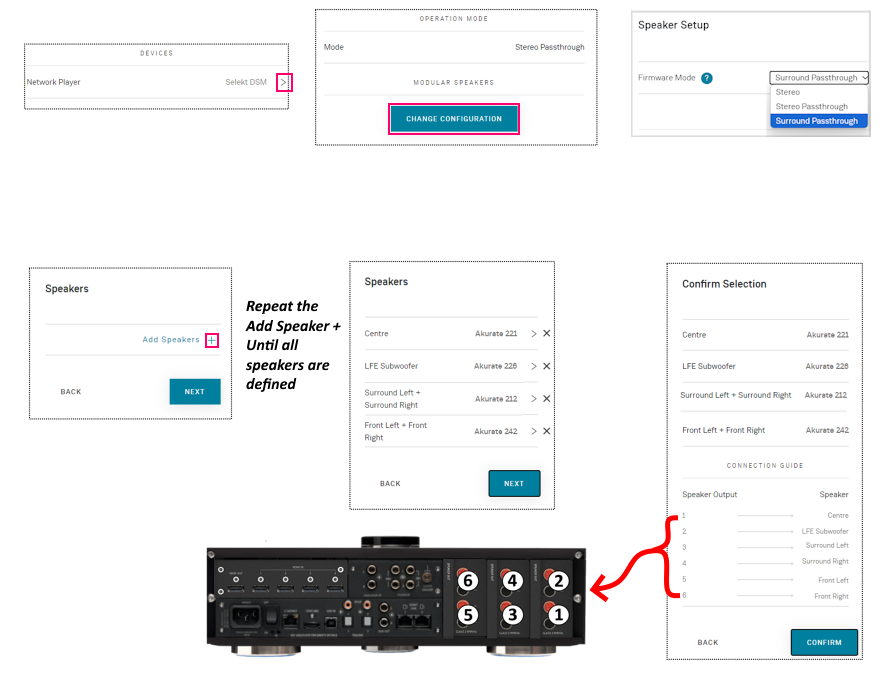
Selekt DSM with 5.1ch Surround with mixed cartridges and an HDMI module with Linn Surround module
- This shows you that up to three cartridges can be fitted to a Selekt DSM.
- These cartridges types can be mixed within the same Selekt DSM.
- For the BEST performance in a Surround setup with mixed modules then we suggest:
- Slot 1 (outer) – HALF & HALF cartridge configured for Centre speaker and Subwoofer.
- Slot 2 (middle) – POWER AMPLIFIER cartridge configured for Left / Right, Surround or Front, speakers
- Slot 3 (inner) – ANALOGUE OUTPUT cartridge configured for Left / Right, Front or Surround, Speakers
- This shows you that up to three cartridges can be fitted to a Selekt DSM.
- Selekt DSM & Selekt Classic DSM
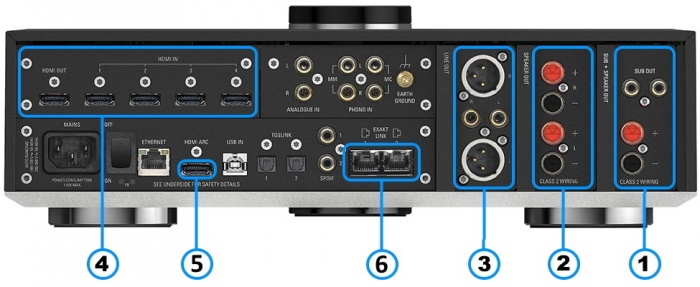
Information of what each connector is and a basic specification of these connectors
- COMBINED OUTPUT Cartridge (RCA & 4mm)1,2,4,5 & 6 - To connect to a Centre loudspeaker and two RCA socket to connect to Subwoofer(s)
- POWER AMPLIFIER OUTPUT Cartridge 1,2,4 & 6 - To connect directly to a pair of loudspeakers.
- ANALOGUE OUTPUT Cartridge (XLR & RCA)1,2,3 - To connect to a power amplifier.
- HDMI SWITCHING MODULE7-Add HDMI switching to the Selekt DSM.
- HDMI ARC - THIS CONNECTION IS NOT USED WHEN AN HDMI SWITCHING MODULE HAS BEEN FITTED.
The HDMI ARC has been moved to the HDMI Switching module HDMI OUT socket - EXAKT LINK- To connect to Exakt compatible devices (Exaktbox, Exakt Speakers, Urika II etc). This means that you not limited to only use these cartidges to output to speakers. You can also use Exakt speakers and/or Exakboxes.
Notes:
1 Each cartridge can be run with Standard or Katalyst DAC Module. (These are fitted internally to the cartridge.)
2 Each cartridge shares the same volume control. That is, change the Selekt DSM volume and all cartridges outputs change to this volume.
3 Analogue Output:
- RCA - 2V rms, 300Ω
- XLR - 4V rms, 600Ω
4 Power Amplifier outputs: These are CLASS-D amplifier outputs and speakers should ONLY be connected/disconnected when the product in is Sleep state or powered OFF.
5 Power Amplifier outputs: Max 100W/4Ω, 50W/8Ω per channel, Gain 20dB
- The Selekt power amplfiers have a slightly lower gain than other Linn power amplifiers, (Majik/Akurate..).
- If you are going to Bi-Amp a pair of speakers then we would recommend either ALL Selekt Power amplifier cartridges or ALL Selekt Line level cartridges with external amplifiers.
- In Surround mode the gain offset can be adjusted on seperate channels to adjust for this offset.
6 Some Electrostatic speakers may require a modification to work with Linn Selekt Class-D amplifier. Please refer to the speaker manufacturers website for information.
7 Adding the HDMI Switching module will DISABLE the onboard HDMI-ARC socket. HDMI-ARC will now work from the HDMI Switch module HDMI OUT socket
- Selekt Edition DSM & Selekt Classic DSM/1
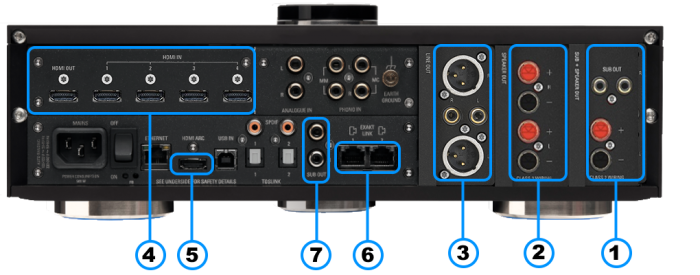
Information of what each connector is and a basic specification of these connectors
- COMBINED OUTPUT Cartridge (RCA & 4mm)1,2,4,5 & 6 - To connect to a Centre loudspeaker and two RCA socket to connect to Subwoofer(s)
- POWER AMPLIFIER OUTPUT Cartridge 1,2,4 & 6 - To connect directly to a pair of loudspeakers.
- ANALOGUE OUTPUT Cartridge (XLR & RCA)1,2,3 - To connect to a power amplifier.
- HDMI SWITCHING MODULE7-Add HDMI switching to the Selekt DSM.
- HDMI ARC - THIS CONNECTION IS NOT USED WHEN AN HDMI SWITCHING MODULE HAS BEEN FITTED.
The HDMI ARC has been moved to the HDMI Switching module HDMI OUT socket - EXAKT LINK- To connect to Exakt compatible devices (Exaktbox, Exakt Speakers, Urika II etc). This means that you not limited to only use these cartidges to output to speakers. You can also use Exakt speakers and/or Exakboxes.
- SUB OUT THIS CONNECTION IS ONLY USED IS STEREO PLAYBACK. IT DOES NOT WORK IN SURROUND FORMATS
Notes:
1 Each cartridge can be run with Organik, Standard and or Katalyst DAC Module. (If using Organik DAC then ALL Selekt Modules MUST have Organik DAC cartidges)
2 Each cartridge shares the same volume control. That is, change the Selekt DSM volume and all cartridges outputs change to this volume.
3 Analogue Output:
- RCA - 2V rms, 300Ω
- XLR - 4V rms, 600Ω
4 Power Amplifier outputs: These are CLASS-D amplifier outputs and speakers should ONLY be connected/disconnected when the product in is Sleep state or powered OFF.
5 Power Amplifier outputs: Max 100W/4Ω, 50W/8Ω per channel, Gain 20dB
- The Selekt power amplfiers have a slightly lower gain than other Linn power amplifiers, (Majik/Akurate..).
- If you are going to Bi-Amp a pair of speakers then we would recommend either ALL Selekt Power amplifier cartridges or ALL Selekt Line level cartridges with external amplifiers.
- In Surround mode the gain offset can be adjusted on seperate channels to adjust for this offset.
6 Some Electrostatic speakers may require a modification to work with Linn Selekt Class-D amplifier. Please refer to the speaker manufacturers website for information.
7 Adding the HDMI Switching module will DISABLE the onboard HDMI-ARC socket. HDMI-ARC will now work from the HDMI Switch module HDMI OUT socket
More Surround options can be seen in the Surround section
Example1: 5.1ch Surround using three Line-level modules
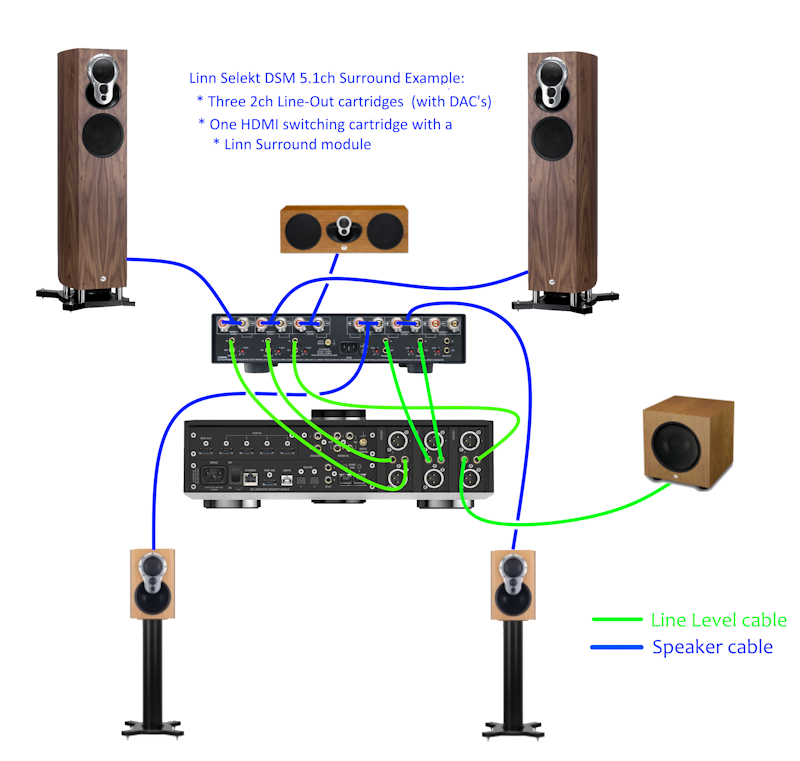
Example2: 5.1ch Surround using Power Amplifier modules and 1.1 module
Example3: 6.0ch Surround using Power Amplifier modules
Download App
- Kazoo (Aug 2023 - Ceased all development)
The Linn DS/DSM can be done from many control points at the same time.
Note: from April 2023 : Tidal have removed support for the Linn Kazoo application on ALL platforms. We recommend trying the new Linn app (available on iOS and Android)
- The name of this control App/software is KAZOO..
- Kazoo control App/software is available for
-
| Windows Kazoo download - from April 2023 : Tidal have removed support for the Linn Kazoo application on ALL platforms. We recommend trying the new Linn app (available on iOS and Android)
-
- Kazoo control App/software is available for
MAC OSX Kazoo download- from April 2023 : Tidal have removed support for the Linn Kazoo application on ALL platforms. We recommend trying the new Linn app (available on iOS and Android)
 Android Kazoo for Android Phone/Tablet download
Android Kazoo for Android Phone/Tablet download- from April 2023 : Tidal have removed support for the Linn Kazoo application on ALL platforms. We recommend trying the new Linn app (available on iOS and Android)
Setup and changes
There are two ways to configure, (if required), your Linn DS/DSM player/Speakers etc:
Before you do anything you will need to have a Linn Account. This is a simple process and can only be performed using the Kazoo App or Linn App.
Details on how to create your Linn Account and how to use Manage systems can be found in the Manage Systems page.
This Konfig App can be downloaded from KONFIG App
This will allow changing the Room name, Linn DS/DSM name, input name and other settings. This can be changes by yourself and/or your Linn Retailer.
Details of most of the options are listed in the Konfig Manual, this covers many options
Konfig has been deprecated and replaced by Manage Systems.
- Note: Manage Systems has taken over from Konfig and we would prefer you to use Manage Systems to setup an configure your Linn products.
Space Optimisation
 for ALL Linn DS/DSM products |
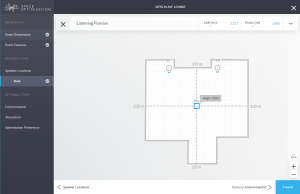 Linn Account Space Optimisation from Davaar64 ⇒ |
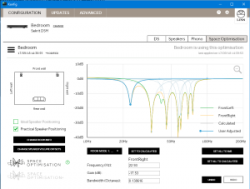 Linn Konfig Space Optimisation & Space Optimisation+ |
Linn Space Optimisation is currently configurable using either the Konfig app or the Linn Account Manage systems.
Click the above picture/icon for more information of that version of Space Optimisation.
More details of what Space Optimisation can be found can be found at www.Linn.co.uk
What are the differences between the Konfig Space Optimisation and Linn Account (Kloud Konfig) Space Optimisation?
- The new version of Space Optimisation uses highly sophisticated acoustic modelling to model the interactions between your speakers and the room; this acoustic modelling is based on the finite-difference time-domain method. A simple two-dimensional analogy to this method of acoustic modelling is of a fishing net laid over a pond; each knot in the net defines a discrete measurement location, so that when a stone is thrown into the pond, we can track the resulting ripple by measuring its height at each knot.
- The spatial discretisation employed by this method of acoustic modelling allows the new version of Space Optimisation to correctly consider the effects of:
- non-rectangular rooms;
- the placement of features like doors and windows;
- And the location and rotation of your speakers.
- Furthermore, the time-domain formulation of this method of acoustic modelling means that the new version of Space Optimisation can now reduce both the energy and decay time of any artificial distortions caused by the interactions between your speakers and the room, resulting in both a flat frequency response and a uniform decay time. :Finally, the new version of Space Optimisation has been designed to give a better balance of low- and mid-frequency energy.
What is the difference between Space Optimisation & Space Optimisation+?
- This is applicable to both Linn Konfig and Manage System/Kloud Konfig
- Space Optimisation is for NON-Exakt systems. This uses the direct analogue outputs of the Linn DS/DSM
Is the Linn Account Manage systems only available for the new Linn DSM's
- Both Applications can be used for ALL Linn Products.
- The only limitation is that the Linn DS/DSM must have Davaar64 to run Linn Account Manage systems]
Why don't you use a Microphone in Space Optimisation?
- The aim of Space Optimisation is to remove the effects of your room, to uncover the unique acoustic characteristics of your speakers; after all, this is what you fell in love with when buying your speakers. To achieve this, Space Optimisation needs to understand both the interactions between your speakers and the room and the unique acoustic characteristics of your speakers; the unique acoustic characteristics of your speakers are then subtracted from the interactions between your speakers and the room, leaving only the effects of your room.
- An acoustic measurement of the interactions between your speakers and room can have many sources of error which may affect the accuracy and repeat-ability of the measurement, including the choice of measurement stimulus, such as MLS or a log chirp; external noise, such as traffic noise and vibration; quality and calibration of the microphone, which can introduce distortion; and the microphone location, which can be sensitive to within a few centimetres. The use of acoustic modelling removes these sources of error: the model can apply an ideal impulse as stimulus; the modelling domain is free from noise; the model can use an ideal microphone; and the listening location is well-defined. It can thus be seen that acoustic modelling has a clear advantage over acoustic measurement in understanding the interactions between your speaker and the room.
- The unique acoustic characteristics of your speakers depend on many factors, including the shape and size of the drive units and ports; the constructive and destructive interference between the drive units, ports and any cabinet-edge diffraction sources; and the angle between the listening location and your speakers. Therefore, a simple on-axis anechoic measurement of your speakers is insufficient information; what is actually required is an anechoic measurement with your speakers in the same configuration as you have them in your home. While some manufacturers do publish anechoic measurements of their speakers, both on- and off-axis, it is extremely unlikely that they will have performed an anechoic measurement of your speakers in the same configuration as you have them in your home. The acoustic modelling of such a scenario is, however, straightforward; the model can simply turn your room into an anechoic chamber to obtain the unique acoustic characteristics of your speakers in the same configuration as you have them in your home. It can thus be seen that acoustic modelling once again has a clear advantage over acoustic measurement in understanding the unique acoustic characteristics of your speakers.
- From the above, it is clear that acoustic modelling is the best approach to Space Optimisation.
Can I use "Linn Account Space Optimisation" with my Exakt system?
- From November 2019 you can now use Linn Account Space Optimisation with Stereo and Surround Exakt systems.
Space Optimisation
 for ALL Linn DS/DSM products |
 Linn Account Space Optimisation from Davaar64 ⇒ |
 Linn Konfig Space Optimisation & Space Optimisation+ |
Linn Space Optimisation is currently configurable using either the Konfig app or the Linn Account Manage systems.
Click the above picture/icon for more information of that version of Space Optimisation.
More details of what Space Optimisation can be found can be found at www.Linn.co.uk
What are the differences between the Konfig Space Optimisation and Linn Account (Kloud Konfig) Space Optimisation?
- The new version of Space Optimisation uses highly sophisticated acoustic modelling to model the interactions between your speakers and the room; this acoustic modelling is based on the finite-difference time-domain method. A simple two-dimensional analogy to this method of acoustic modelling is of a fishing net laid over a pond; each knot in the net defines a discrete measurement location, so that when a stone is thrown into the pond, we can track the resulting ripple by measuring its height at each knot.
- The spatial discretisation employed by this method of acoustic modelling allows the new version of Space Optimisation to correctly consider the effects of:
- non-rectangular rooms;
- the placement of features like doors and windows;
- And the location and rotation of your speakers.
- Furthermore, the time-domain formulation of this method of acoustic modelling means that the new version of Space Optimisation can now reduce both the energy and decay time of any artificial distortions caused by the interactions between your speakers and the room, resulting in both a flat frequency response and a uniform decay time. :Finally, the new version of Space Optimisation has been designed to give a better balance of low- and mid-frequency energy.
What is the difference between Space Optimisation & Space Optimisation+?
- This is applicable to both Linn Konfig and Manage System/Kloud Konfig
- Space Optimisation is for NON-Exakt systems. This uses the direct analogue outputs of the Linn DS/DSM
Is the Linn Account Manage systems only available for the new Linn DSM's
- Both Applications can be used for ALL Linn Products.
- The only limitation is that the Linn DS/DSM must have Davaar64 to run Linn Account Manage systems]
Why don't you use a Microphone in Space Optimisation?
- The aim of Space Optimisation is to remove the effects of your room, to uncover the unique acoustic characteristics of your speakers; after all, this is what you fell in love with when buying your speakers. To achieve this, Space Optimisation needs to understand both the interactions between your speakers and the room and the unique acoustic characteristics of your speakers; the unique acoustic characteristics of your speakers are then subtracted from the interactions between your speakers and the room, leaving only the effects of your room.
- An acoustic measurement of the interactions between your speakers and room can have many sources of error which may affect the accuracy and repeat-ability of the measurement, including the choice of measurement stimulus, such as MLS or a log chirp; external noise, such as traffic noise and vibration; quality and calibration of the microphone, which can introduce distortion; and the microphone location, which can be sensitive to within a few centimetres. The use of acoustic modelling removes these sources of error: the model can apply an ideal impulse as stimulus; the modelling domain is free from noise; the model can use an ideal microphone; and the listening location is well-defined. It can thus be seen that acoustic modelling has a clear advantage over acoustic measurement in understanding the interactions between your speaker and the room.
- The unique acoustic characteristics of your speakers depend on many factors, including the shape and size of the drive units and ports; the constructive and destructive interference between the drive units, ports and any cabinet-edge diffraction sources; and the angle between the listening location and your speakers. Therefore, a simple on-axis anechoic measurement of your speakers is insufficient information; what is actually required is an anechoic measurement with your speakers in the same configuration as you have them in your home. While some manufacturers do publish anechoic measurements of their speakers, both on- and off-axis, it is extremely unlikely that they will have performed an anechoic measurement of your speakers in the same configuration as you have them in your home. The acoustic modelling of such a scenario is, however, straightforward; the model can simply turn your room into an anechoic chamber to obtain the unique acoustic characteristics of your speakers in the same configuration as you have them in your home. It can thus be seen that acoustic modelling once again has a clear advantage over acoustic measurement in understanding the unique acoustic characteristics of your speakers.
- From the above, it is clear that acoustic modelling is the best approach to Space Optimisation.
Can I use "Linn Account Space Optimisation" with my Exakt system?
- From November 2019 you can now use Linn Account Space Optimisation with Stereo and Surround Exakt systems.
Front Panel
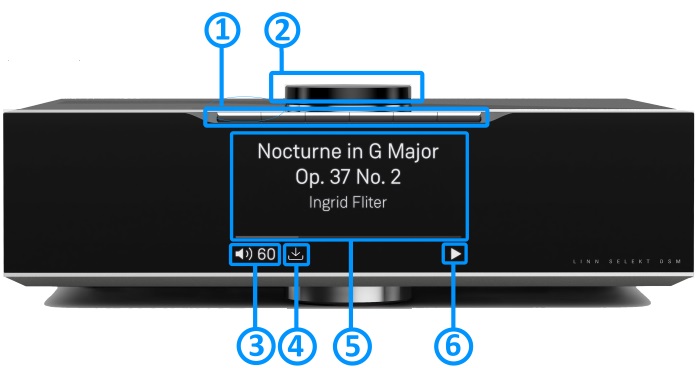
- * Press the button gently, turned as a "half press" to check what the button will do.
- * Fully press the press to button to action/select this PIN operation.
- Creation of PINS can be found in the Linn App Manuals
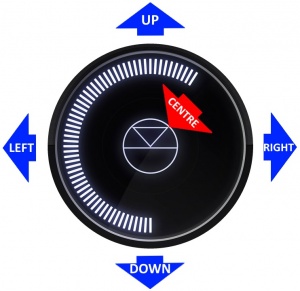
- GO INTO SLEEP:
- Press the dial CENTRE and continue to press the CENTRE (approx 2seconds) until the volume indicator dial starts to decrease.
- BRING OUT OF SLEEP:
- Press any of the UP/DOWN/LEFT/RIGHT or CENTRE of the dial.
- SOURCE SELECT
- Press the dial DOWN to list the inputs available menu
- Scroll UP/DOWN the selection.
- Press RIGHT to select source or LEFT to cancel selection menu
- PLAY/STOP/PAUSE- MUTE/UNMUTE
- A quick press of the dial CENTRE will toggle between PLAY and STOP/PAUSE
- (Radio-PLAY/STOP, Playlist-PLAY-PAUSE).
- (Other sources-Mute/Unmute).
- TRACK/PRESET PREV/NEXT
- A quick press of the dial LEFT/RIGHT jump to Playlist tracks or Radio stations.
- Volume
- Rotate dial clockwise to increase volume, anti-clockwise to reduce volume. The dial indicators will tell you the present volume.
- LINN DSM INFORMATION
- Software version
- With the Selekt DSM out of Sleep mode
- Press dial UP to enter Service menu
- Scroll UP/DOWN to highlight "Software Update"
- Press RIGHT to select or LEFT to cancel Service menu
- Selekt "Properties" (Room name, device name, IP address etc)
- Press dial UP to enter Service menu
- Scroll DOWN to highlight "Properties"
- Press RIGHT to select Properties
- Scroll DOWN to highlight "Device"
- Press RIGHT to select Device
- Selekt "Settings" (|Balance, Lipsync, Surround volumes etc)
- Press dial UP to enter Service menu
- Scroll DOWN to highlight "Settings"
- Press RIGHT to select or LEFT to cancel Settings menu
Note: Cancel any previous menus by pressing LEFT key.
- SURROUND TRIM
- With the Selekt DSM out of Sleep mode
- Press dial UP to enter Settings menu
- Press RIGHT to select or LEFT to cancel Settings menu
- Scroll UP/DOWN to highlight "Surround"
- Press RIGHT to select or LEFT to cancel Surround menu
- Select a the channel and trim with UP/DOWN
My Selekt DSM has a RED Linn symbol on the dial, what does this mean?
 If you do not have a live network/LAN connection on the Selekt DSM the Linn symbol on the dial will go red.
If you do not have a live network/LAN connection on the Selekt DSM the Linn symbol on the dial will go red.
- If your network cable is plugged in and your network/LAN is alive then check that you have the network/LAN cable plugged into the LAN socket (#3 on the back panel diagram) and NOT the Exakt socket (#10 back panel diagram).
 After a live network/LAN connection is made the LINN symbol on the dial will turn white after 5-10 seconds.
After a live network/LAN connection is made the LINN symbol on the dial will turn white after 5-10 seconds.
I get a flashing Linn icon on the volume dial, what does this mean?

- This means that the Selekt DSM is in :
- Searching for Exakt speakers after being woken from Sleep (typically only flashes for a couple of seconds after waking from Sleep)
- or
- FALLBACK mode : Fallback is a state that means that the product is waiting for a software update. To stop this flashing either:
What does the shimmering dial mean?
This is to show that the Selekt DSM is starting up after a mains power on. It will typically do this in 30–45 seconds, but if the Linn Selekt DSM is performing a software update, this may take a little longer.
What does a dim/bright dial mean?
This is to show when the Selekt DSM is in Mute mode.
- To show the current volume value and mute condition.
- This is your Selekt DSM telling you that a software update is available.
- The update is not compulsory, just an indication that an update is available.
- A Software update is performed by:
- the dial settings to do a Software update,
- Press the UPPER part of the dial. The front panel display will now show System options.
- Press the LOWER part of the dial to highlight "SOFTWARE UPDATE"
- Press the RIGHT part of the dial to select this option.
- If a Software update is available you will see the Agree to update message and pres the RIGHT part of the dial to select this option.
- Manage Systems - Software Updates,
- IR handset or Linn App.
- Instructions on how to do this update are listed HERE
- Using the IR handset i button to wake up and further presses allow you to scroll throught the display available.
- On the Playlist this is typically Artist, Album & codec information. The lower bar will show the track position information
- On a Radio source this will show the information provided by the radio station and the codec information
- ......
- Shows the Play / Stop / Pause / Buffering symbols to show the current transport state.
- (This is blank when a local input, such as HDMI, is selected)
- if an
 image appears, this indicates no network. After the network is re-established, this will go back to its last transport or blank state.
image appears, this indicates no network. After the network is re-established, this will go back to its last transport or blank state.
General products manuals and information
Controlling the product User Guide

